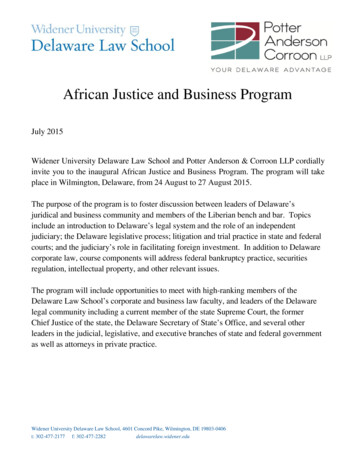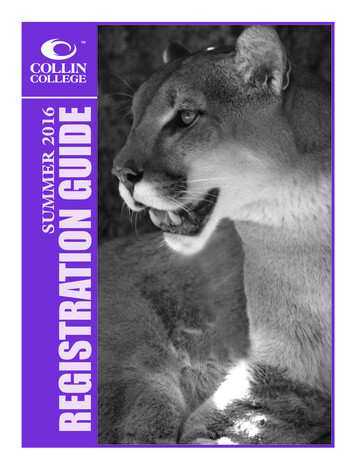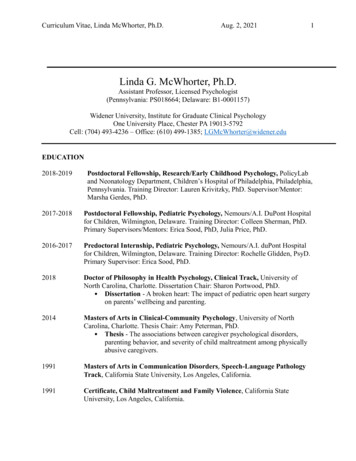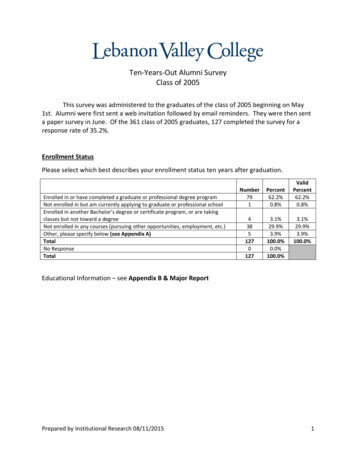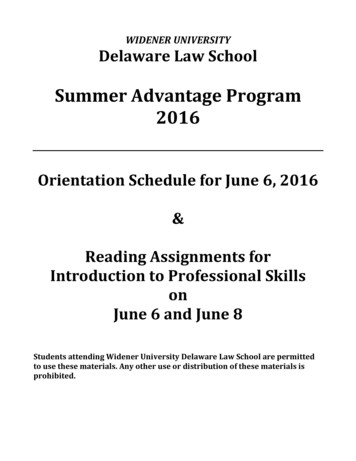
Transcription
WIDENER UNIVERSITYDelaware Law SchoolSummer Advantage Program2016Orientation Schedule for June 6, 2016&Reading Assignments forIntroduction to Professional SkillsonJune 6 and June 8Students attending Widener University Delaware Law School are permittedto use these materials. Any other use or distribution of these materials isprohibited.
SECTION ISCHEDULE FOR JUNE 6, 201610:00 a.m. – 6:00 p. m.Registration (Admissions Office)5:45 p.m. – 6:20 p.m.Light Dinner Fare6:20 p.m. – 6:40 p.m.Welcome from Deans and Office of Student Affairs6:40 p.m. – 7:30 p. m.Financial Aid Workshop7:30 p.m. – 7:40 p.m.Break7:40 p.m. – 9:30 p.m.Introduction to Professional SkillsExpert Learning: Case Briefing and AnalysisAttendance is required at the orientation sessions beginning at 6:20 p.m. on June 6. A record ofattendance is kept for all law school courses, including the program on June 6.Section IIIntroduction to Professional SkillsMany students find law school very different from other school experiences. The subject mattersmay be new, the workload is heavy, and the vocabulary used in law school seems alien. Even thetesting and grading processes in law school are often different from processes employed in othereducation settings.The Introduction to Professional Skills program (IPS) is a series of required classes designed toprepare students for unique features of a law school education. The program provides a commonbody of knowledge for all students in the first semester. In addition, the IPS classes provideopportunities to discuss and practice skills essential to a successful performance as a law studentand as a member of the legal profession. Portions of the Lab times scheduled for Wednesdaynights in June and July for the Summer Advantage Program will be used to cover many of thelearning and lawyering skills addressed in the IPS program.Students who do not participate in the Summer Advantage Program will complete the IPS classesduring the orientation week to be held from August 16 through August 18. Students whocomplete the Summer Advantage Program are invited – but not required -- to attend all of theorientation sessions that will be held for JD students in August. Why would you want to attendIPS classes in August after completing the Summer Advantage Program? Well, the IPS classestaught in August will use subject matters taught in the first year of law school other thanCriminal Law to set contexts.Please note, however, students in the Summer Advantage Program are required to attendthe orientation sessions that will be held August 17, 2016.1
Section IIIa. Readings to Complete for Introduction to Professional Skills on June 6, 2016You have two reading assignments to complete before the orientation on Monday, June 6, 2016.First, please read chapters 1 through 4 of Tracey George & Suzanna Sherry, What Every LawStudent Really Needs to Know: An Introduction to the Study of Law. You may purchase theGeorge & Sherry text from the bookstore on campus as well as from any online book vendor.This book provides a common body of knowledge useful for all students in the first semester oflaw school. The second assignment for June 6 is to read the materials in Section IV below andprepare to discuss those materials in class.b. Readings to Complete for the Applied Learning Lab June 8, 2016The assignment for the Applied Learning Law on June 8, 2016 is to actively read the materials inSection V below and prepare to discuss those materials in class.c. Professional Duties of Competence and DiligenceCompetence and diligence are foundations of the practice of law as a profession.1 Competencerequires knowledge of the law, skill in using that knowledge and thorough preparation. You areexpected, therefore, to read the materials assigned for each class and to prepare to address thosematerials in class. You may initially get confused, frustrated, and intimidated in developing yourunderstanding of the law, but remember you are required to be diligent as a lawyer. Professionaldiligence requires a lawyer “to pursue a matter . . . despite opposition, obstruction, or personalinconvenience . . . .”2 You can do this! Look at how many others have done so.SECTION IVExpert Learning in Law School: Case Briefing and AnalysisMany new law students approach reading in law school as they have approached reading all oftheir lives – as if reading a narrative -- which is to say passively. Active reading skills, however,are necessary for successful performance in law school. Studies have shown that active readingstrategies correlate to better grades in law school.3 In a variety of ways, active readers engagewith readings more deeply than passive readers. Active readers wrestle with assigned materials.1Rule 1.1 of the American Bar Association’s Model Rules of Professional Conduct provides: “A lawyer shall provide competentrepresentation to a client. Competent representation requires the legal knowledge, skill, thoroughness and preparationreasonably necessary for the representation.” Model Rule 1.3 provides: “A lawyer shall act with reasonable diligence andpromptness in representing a client.” Most States have used the ABA’s Model Rules as a template.2Model Rules of Professional Conduct 1.3, Comment [1].3See, e.g., Leah M. Christensen, Legal Reading and Success in Law School: An Empirical Study, 30 Seattle U. L. Rev 603 (2007)2
Because many law school subjects are taught through reading and discussing judicial opinions(“cases”), your IPS class on June 6 will introduce you to active reading strategies and techniquesas means for reading cases effectively. To begin to develop your competence in analyzing casesfor meaning and utility, we will apply active reading skills to two cases addressing the concept ofconstructive possession as an element of certain crimes. In particular, we will highlight theprocess of creating a case brief, an active reading process students will continue to honethroughout the first year of law school.a. Active Reading StrategiesA basic process for active reading includes: (1) pre-reading strategies, (2) strategies whilereading, and (3) post-reading strategies. Each step is described below.1. Pre-Reading StrategiesFirst, before reading a text, an active reader has a purpose for the reading. To set a purpose activereaders use prediction and goal setting. An active reader takes a moment to predict what thereader might get from reading certain materials. What is the case about and why has myprofessor assigned the reading? During the semester you also might consider how a new readingfits with material previously assigned and discussed.One can use context clues such as headings on a course syllabus, a book’s table of contents, ornotes and questions following a case4 in a course text for prediction. Or, if more than one case isassigned on a single topic, such as the two cases on constructive possession that follow, onemight predict that the second opinion provides a different explanation of the law than the firstopinion provided, provides a different example than the first opinion of fact patterns constitutingconstructive possession, or provides an example of facts that do not constitute constructivepossession.Before reading, you should set a goal for the reading based on the predictions made. Forexample, with respect to the two cases on constructive possession, “When I am finished readingthese cases, I will know all of the elements necessary for constructive possession.” Or, “When Iam finished reading these cases, I will have constructed a case brief to understand the meaningand precedential value of the cases.”2. Strategies While ReadingWhile reading a judicial opinion, you should read with your “purpose(s)” in mind. You are notjust reading the court’s words; you are searching for certain types of information to fulfill yourpurposes. For example, you will be looking for the court’s words describing the necessaryelements of constructive possession. You also should research vocabulary that is new to you.Finally, you should work to understand parts of the opinion you initially find confusing beforecontinuing with your reading of the remaining parts of the opinion. If a particular part of an4In many law school text books, a court opinion often is followed by notes and questions providing additional information aboutthe issues addressed in the opinion and raising concerns about the opinion. No rule of law, physics or good nutrition, however,prohibits you from scanning the notes and questions before reading the court opinion.3
opinion remains indecipherable on first reading, you could try reading the remainder of theopinion to see if the context of the whole helps to understand how the difficult part fits.5“Briefing” a case is a critical active reading strategy for new law students. Creating a written“brief” of a court opinion provides a framework for understanding the new information in anopinion by helping to sort the information into categories useful to a competent lawyer. Thesorting will not only help you absorb and recall new information, it also will help you understandhow you might competently use the new information. Much of class time during the first yearwill be devoted to refining your ability to construct such frameworks necessary for professionalcompetence. The skills developed in creating case briefs are vital for class preparation, exampreparation, and for much of the legal analysis lawyers do.3. Post-Reading AssessmentWhen you finish reading cases, you should assess whether your predictions for the reading werecorrect and whether you accomplished your purposes for the reading. For example, does thesecond case below provide new factual examples of constructive possession? Are you able to setforth accurate and complete statements of the elements of constructive possession? Are you ableto identify the material facts each court identified in its opinion for purposes of assessing theprecedential value of the opinion?Experts also recommend evaluating a court’s decision as a means of engaging deeply in thereading of the opinion. Here are a couple of questions you might use for such an evaluation. “Ifone of the material facts in the opinion were changed from X to Y, how would that have affectedthe court’s decision?” “Do I agree with the court’s decision?”b. Practicing Active Reading Strategies in Analyzing PrecedentFor the judicial opinions that follow, we are asking you to engage in one of the essential skills of acompetent lawyer, i.e. “the analysis of precedent.”6 Use the active reading strategies describedabove, including the creation of case briefs for each opinion.We appreciate that active reading strategies such as prediction, goal setting and case briefingmay be new to you. You will get better at such activities over time. To help with your efforts atbriefing cases, the next three pages contain an annotated template for constructing a case brief.The two cases on constructive possession follow the template.5For additional means of active reading, see Tracey E. George & Suzanna Sherry, What Every Law Student Really Needs to Know:An Introduction to the Study of Law, 65-71(2009).6Model Rule of Prof’l Conduct R. 1.1, Comment 2 (2014).4
CASE OPINION (AND POSSIBLE BRIEF) COMPONENTSCASE COMPONENTDESCRIPTION1. CaseTitle, Court & YearTitle of the case, court and date2. PartiesNames, ProceduralDesignationBrief description of who is suing whom and role ofeach in the litigation3. Procedural Historya.k.a. ProceduralFacts (includesProceduralPosture)Brief description of what has happened in the casesince the lawsuit was filed; should be distinguishedfrom the substantive facts of the case (see #4below).Procedural posture: where the case is now, e.g.,on appeal.4. Facts5. Issue(s)Brief description of what happened to cause oneparty to initiate litigation and the facts affecting thecourt’s decision. Sometimes these are called thesubstantive facts or determinative facts (asdistinguished from the procedural facts). (As withall components of a brief, you also should beguided by what your professor likes to discuss inclass.)[Fill in].The legal question or questions the court mustdecide. Typically includes substantive facts plusreference to a rule of law. There will always be atleast one issue, and often there are multiple issuesin a case.5
CASE COMPONENT6. Holding &Disposition7. Rules (a.k.a. thelaw)DESCRIPTIONHolding is the answer to the issue and primarylegal conclusion in the case.Disposition is the legal result for the particularcase, e.g., “Affirmed” or “Granted.” Often found atthe end of the opinion.Rules or laws existing prior to the case at handand which are used to decide the case; caninclude statutes, regulations, rules of procedure,common law, etc.The laws existing prior to the instant case beingdecided are referred to as “precedent.”Courts also will often announce new rules orinterpretations of precedent.The holding(s) in a case are also a form of law orrule upon which future litigants can rely.Some professors consider the rules discussed in acase to be part of the court’s reasoning (see #9below).8. Arguments(Made to the court byeach party in the case.)Not always easily discernible; the arguments oftenmerge with or form the basis for the court’sreasoning (see #9 below).Arguments are generally an optional component.Include arguments in your brief if your professorlikes to discuss the arguments in class.6
CASE COMPONENTDESCRIPTION9. ReasoningDescription of why the court ruled as it did. Caninclude precedent (see #7 above), policyconsiderations, etc.The court’s reasoning is not always apparent.10. Miscellaneousa. Concurring anddissentingopinions, if any.b. Dictumc. Your own comments,questions, etc.a. Concurring and dissenting opinions are not lawbut they are often the subject of class discussionsand can help you understand the main opinion.b. Dictum likewise is not law but may be useful toinclude in a brief for the same reasons you mightinclude concurring and dissenting opinions.c. You might include in your briefs your ownquestions and comments to focus your classparticipation and case understanding.7
United States v. Jenkins, 90 F.3d 814 (3d Cir. 1996)Before Stapelton , Scirica and Cowen, Circuit Judges.OPINION OF THE COURTStapelton, Circuit Judge:Sean Jenkins appeals his conviction on drug possession and related firearms charges. He challenges thesufficiency of the evidence to establish his constructive possession of drugs found near him. Because theevidence showed only that he was in an acquaintance's apartment physically near but not in actualpossession of drugs and drug distribution paraphernalia, it does not support the jury's finding that he haddominion and control over the drugs. We will, therefore, reverse Jenkins' conviction on all counts.IAround 1:30 a.m. on February 10, 1994, Philadelphia police officers Michael Kopecki and JamesSantomieri responded to a call that shots were being fired near an apartment building. Entering thecourtyard of the building, the officers saw Kevin Jones and Larry Harrison, who was holding a handgun.Kopecki yelled, “Police!” Harrison ran into the building, and the officers chased him through a fire escapedoor, down a hallway, and into apartment C-107. The front door opened into the living room, and theofficers found Sam Stallings and Jenkins seated on a couch, both wearing only boxer shorts and a t-shirt.On the coffee table before them were three bags of white powder containing a total of 55.3 grams ofcocaine and 42 grams of non-cocaine white powder, two triple-beam scales, two loaded .38 caliberrevolvers, small ziplock-style bags, clear plastic vials, and numerous red caps. On the floor was a loadedsawed-off shotgun.None of the cocaine powder had been put in the bags, vials, or caps, and there was no evidence that eitherman had been working with the cocaine. No grinders, razor blades, or other “cutting” implements, wereon the table, and no pots or other instruments that could be used to cook cocaine were found with anycocaine residue. No cocaine residue was found on Stallings or Jenkins, including their hands, and noresidue was found on the scales. Nothing concerning Jenkins' clothing suggested any connection to thedrugs. Finally, he made no attempt to hide or destroy the contraband, and fully cooperated with theofficers.Stallings and Jenkins were charged and tried together. Count I of the indictment charged them withpossession of cocaine with intent to distribute. At trial, the officers testified to what they saw and found,as described above. An expert witness, DEA agent Ellis Hershowitz, testified that the scales, bags and vialswere commonly used by drug traffickers in repackaging drugs for resale. On cross-examination,Hershowitz acknowledged that instruments necessary to cut and apportion the cocaine and insert it intothe various packages were not found in the apartment. The manager of the apartment building, BarbaraEdward, identified Stallings as a tenant in C-107, Harrison as someone who lived there, and Jenkins assomeone who was “in and out” with Stallings and Harrison. Neither defendant testified.The jury found Jenkins guilty on both counts.IIIn reviewing a jury verdict for sufficiency of the evidence, we view the evidence in the light mostfavorable to the government, and we will affirm the conviction if a rational trier of fact could have foundthe defendant guilty beyond a reasonable doubt. See United States v. Brown, 3 F.3d 673, 680 (3d Cir.),cert. denied, 510 U.S. 1017, 114 S.Ct. 615, 126 L.Ed.2d 579 (1993). The district court had jurisdiction8
pursuant to 18 U.S.C. § 3231, and we have jurisdiction pursuant to 28 U.S.C. § 1291. The notice of appealwas timely filed.IIIA.The government had no evidence of actual possession of the cocaine powder; consequently, the issuebefore us is whether there was evidence sufficient to establish constructive possession. Under ourprecedent, the evidence must show that Jenkins had dominion and control over the drugs:[T]he government must submit sufficient evidence to support an inference that the individual “knowinglyhas both the power and the intention at a given time to exercise dominion or control over a thing, eitherdirectly or through another person or persons. Constructive possession necessarily requires both‘dominion and control’ over an object and knowledge of that object's existence.” United States v. Iafelice,978 F.2d 92, 96 (3d Cir.1992) (citations omitted), Brown, 3 F.3d at 680. The kind of evidence that canestablish dominion and control includes, for example, evidence that the defendant attempted to hide or todestroy the contraband, see United States v. Davis, 461 F.2d 1026, 1034-36 (3d Cir.1972), or that thedefendant lied to police about his identity or the source of large amounts of cash on his person, see UnitedStates v. Brett, 872 F.2d 1365, 1368-69 (8th Cir.), cert. denied, 493 U.S. 932, 110 S.Ct. 322, 107 L.Ed.2d 312(1989). Dominion and control are not established, however, by “mere proximity to the drug, or merepresence on the property where it is located or mere association with the person who does control thedrug or the property.” Brown, 3 F.3d at 680; see also United States v. Dunlap, 28 F.3d 823, 826 (8thCir.1994); United States v. Zeigler, 994 F.2d 845, 848 (D.C.Cir.1993); United States v. Vasquez-Chan, 978F.2d 546, 550 (9th Cir.1992).Jenkins argues that the evidence relied upon by the court was insufficient to prove dominion and controlover the cocaine. Nothing but proximity links him to the drugs and drug distribution paraphernalia. Nococaine residue was found on him, nor were his fingerprints found on the drugs. His prior acquaintancewith Stallings answers why he was in the apartment, and it is immaterial how long he had been or wasgoing to be there. The presence of the two scales, he contends, is insufficient to link him to the drugs. Noevidence suggests that they had been in use or were about to be used by him; if anything, it was morelikely that the two scales belonged to and would be used by the two residents of the apartment.We agree with the defendant that the evidence is insufficient to establish his possession of the cocaine.The evidence does show that he is an acquaintance of Stallings and Harrison and that he was foundphysically near drugs and drug distribution paraphernalia, including two scales, but those are insufficientfacts from which to infer dominion and control over the drugs.We find this case controlled by our decision in United States v. Brown. The police, acting on a tip, searchedBrown's home for drugs. During the search, Ama Baltimore arrived at the house, inserted a key into thelock, and was arrested as she entered. While being arrested, she protested, “But you can't arrest mebecause I am in my own house.” In the upstairs sewing room, the police found a pair of shorts and aswitchblade, both of which Baltimore admitted were hers. Substantial quantities of heroin, cocainepowder, and crack cocaine were found in the refrigerator in the kitchen, the kitchen closet, and one of theupstairs bedrooms. Equipment and supplies to prepare, cook, cut and distribute the drugs were alsofound in the bedroom. The government contended that several facts were sufficient to establishBaltimore's possession of the drugs: her possession of a key to the house, her attempted entry, thepresence of the shorts and switchblade in the house, her statement, and the fact that the house was aknown “cut house,” a place where large quantities of drugs are cut and distributed.We overturned her conviction for insufficient evidence of possession. The evidence showed that she hadaccess to or resided in the house and knew of the presence of the drugs, but did not show she haddominion and control them. The key, her attempted entry, and her statement merely showed that she had9
some control over the house, not the drugs. See 3 F.3d at 682-83. We further noted that her fingerprintswere not found on the drugs or drug paraphernalia, and there was no evidence that she ever exerted anyindirect control over them. See id. Evidence in addition to knowledge of and access to the drugs wasnecessary to prove possession. The fact that Brown's home was a “cut house” did not suffice as additionalevidence. Because Brown's house was also a residence, the jury could not infer from the fact that Brown'shome was a “cut house,” that beyond a reasonable doubt, Baltimore was a participant in the drugdistribution operation. See id. at 683-84.Our decision in Brown is consistent with the jurisprudence of other circuits. In United States v. VasquezChan, the Court of Appeals for the Ninth Circuit found evidence of drug possession insufficient eventhough there was proof that the defendant had access to and was in close proximity with large quantitiesof drugs. Drug Enforcement Agency officers arranged the purchase of a large amount of cocaine. Theyobserved the drugs being transported from a particular house and went to secure the residence. Inside,they found two women, a housekeeper and an apparent house guest, Julia Gaxiola-Castillo (Gaxiola).Gaxiola waived her rights and told the officers that she was a friend of the housekeeper and had beenstaying there a few weeks with her infant child. In the bedroom where she had been staying, the officersfound 600 kilograms of cocaine in 55 gallon drums. On six of the drums, including the inside of the lid ofone drum, they found her fingerprints. She was convicted of conspiracy to possess narcotics with intent todistribute.The Ninth Circuit overturned the conviction for lack of evidence of possession. She claimed that she hadcome to visit her friend, and she and her child had to sleep somewhere, and the bedroom with the cocainemay have been the only place to stay. Although the defendant had been caught in “extremelyincriminating circumstances” due to her proximity to the drugs, her behavior “was perfectly consistentwith that of an innocent person having no stake or interest in the transactions.” 978 F.2d at 551 (citationsomitted). Proximity and knowledge of the existence and location of the drugs were insufficient to provedominion and control. See id. The fingerprints by themselves proved nothing but the fact that she hadused the bedroom. It was perfectly reasonable to believe that she would have come into contact with thenumerous canisters as she moved in and out of the room, or prepared a place to sleep. See id.Similarly, in United States v. Dunlap, the Court of Appeals for the Eighth Circuit found proximity to drugsunder very suspicious circumstances insufficient to support a finding of possession. Acting on a tip thatdrugs were being sold from Eric Dunlap's apartment, police officers secured a search warrant. As theyapproached his door, Dunlap opened the door from the inside. Standing behind Dunlap was CorneliusColeman, who had a handgun in his pocket. In the kitchen, the officers found large amounts of cocainepower and cocaine base, and some of the powder was in the process of being cooked. Coleman's hat wasalso in the kitchen, and more drugs and drug distribution paraphernalia were found in the apartment.Coleman was convicted of possession with intent to distribute cocaine. The Eighth Circuit overturned hisconviction because the evidence was not sufficient for a jury to find beyond a reasonable doubt thatColeman had constructive possession. See 28 F.3d at 826. His mere presence in the apartment, includingthe evidence that he may have been in the kitchen, did not prove that he possessed the cocaine. He mayhave been visiting Dunlap to purchase cocaine for his own use, an offense not charged, and it wasspeculative for the jury to conclude beyond a reasonable doubt that he possessed the drugs, or intendedto aid and abet Dunlap in his drug operation. See id. at 827.The evidence supporting constructive possession in Sean Jenkins' case is no stronger than the evidencefound insufficient in Brown, Vasquez-Chan, and Dunlap. In each of those cases, the evidence did notestablish the decisive nexus of dominion and control between the defendant and the contraband. Thedistrict court believed that Jenkins' being on the couch next to the drugs was decisively different than if hewas somewhere else in the apartment, but proximity alone is not enough, no matter how near thatproximity is. Without other proof of dominion and control, we can only conclude that it was sheerhappenstance that Jenkins was seated on the couch next to the cocaine when the police entered the10
apartment. Whether or not he possessed the drugs, he could have been found sitting on the couch,standing next to it, in the bathroom, or in some other room in the apartment. A reasonable jury may notinfer dominion and control beyond a reasonable doubt from the defendant's physical distance from thedrugs alone.The government relies on our decisions in United States v. Davis, 461 F.2d 1026 (3d Cir.1972) and UnitedStates v. Iafelice, 978 F.2d 92 (3d Cir.1992). In both cases, however, there were significant and substantialfactors linking the defendants to the drugs. In Davis, the defendant was convicted for possessing herointhat had been seized in her apartment. Unlike the instant case, in Davis the evidence clearly showed thatsomeone had been recently packaging the drugs, and when the police forced their way in, the personspresent, including the defendant, had tried to destroy the drugs. 461 F.2d at 1035-36. Here, Jenkins was inan acquaintance's apartment and no evidence suggests that he had recently physically interacted with thedrugs or drug paraphernalia. Neither did he attempt to hide or destroy the drugs. In Iafelice, thedefendant drove several individuals in his car to a pre-arranged drug sale to undercover agents, and wasconvicted for possession of heroin. We upheld the conviction and found relevant that he drove the car in asuspicious manner, transported the drugs and those who sold the drugs to the point of sale, assisted inopening the trunk where the drugs were located, and was called in the car by one of the principal drugdealers during the sale. See Iafelice, 978 F.2d at 95-98. Here, the cocaine was not found in Jenkins'residence, and no evidence suggests his active participation in any drug distribution.A sufficiency of the evidence challenge requires us to take a careful look at the evidence in the light mostfavorable to the government. Because the evidence supporting Jenkins' possession of the cocaine, viewedin that light, does not amount to more than close proximity to the drugs and acquaintance with theresidents of the apartment in which the drugs were found, we must reverse his conviction for possessionwith intent to distribute.SECTION VCommonwealth v. Jackson, 540 Pa. 556, 659 A.2d 549 (Pa. 1995)PER CURIAM.The Court being evenly divided, the Order of the Superior Court is affirmed.PAPADAKOS, J., did not participate in the decision of this case.NIX, C.J., files an Opinion in Support of Affirmance.CASTILLE, J., files an Opinion in Support of Affirmance in which MONTEMURO, J., joins.ZAPPALA, J., files an Opinion in Support of Reversal in which FLAHERTY and CAPPY, JJ., join.OPINION IN SUPPORT OF AFFIRMANCENix, C. J.Following a bench trial, appellant was convicted of possession of a controlled substance and possession ofa controlled substance with intent to deliver. Post-trial motions were denied and appellant wassentenced to the mandatory minimum sentence of four to eight years imprisonment. The Superior Courtaffirmed appellant's judgment of sentence. This Court granted allocatur to examine whether the evidencewas sufficient to support appellant's convictions.11
Appellant's sole claim before this Court is that the evidence is insufficient to sustain her convictions. It iswell established that when reviewing a sufficiency of the evidence claim, an appellate court mustdetermine whether the evidence was sufficient to enable the factfinder to find every elemen
Summer Advantage Program 2016 Orientation Schedule for June 6, 2016 Reading Assignments for Introduction to Professional Skills on June 6 and June 8 Students attending Widener University Delaware Law School are permitted to use these materials. Any other use or distribution of these materials is prohibited. 1 SECTION I
